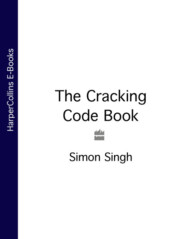По всем вопросам обращайтесь на: info@litportal.ru
(©) 2003-2024.
✖
The Code Book: The Secret History of Codes and Code-breaking
Автор
Год написания книги
2018
Настройки чтения
Размер шрифта
Высота строк
Поля
The Code Book: The Secret History of Codes and Code-breaking
Simon Singh
The Science of Secrecy from Ancient Egypt to Quantum CryptographyFrom the best-selling author of Fermat’s Last Theorem, The Code Book is a history of man’s urge to uncover the secrets of codes, from Egyptian puzzles to modern day computer encryptions.As in Fermat’s Last Theorem, Simon Singh brings life to an anstonishing story of puzzles, codes, languages and riddles that reveals man’s continual pursuit to disguise and uncover, and to work out the secret languages of others.Codes have influenced events throughout history, both in the stories of those who make them and those who break them. The betrayal of Mary Queen of Scots and the cracking of the enigma code that helped the Allies in World War II are major episodes in a continuing history of cryptography. In addition to stories of intrigue and warfare, Simon Singh also investigates other codes, the unravelling of genes and the rediscovery of ancient languages and most tantalisingly, the Beale ciphers, an unbroken code that could hold the key to a $20 million treasure.Note that it has not been possible to include the same picture content that appeared in the original print version.
The Code Book
The Secret History of Codes and Codebreaking
Simon Singh
Copyright (#ulink_c9f3eff0-87f2-543b-a506-98fc1641006b)
HarperCollinsPublishers Ltd 1 London Bridge Street, London SE1 9GF www.harpercollins.co.uk (http://www.harpercollins.co.uk) THE CODE BOOK . Copyright © Simon Singh 1999. The right of Simon Singh to be identified as the author of this work has been asserted by him in accordance with the Copyright, Designs and Patents Act 1988. A catalogue record for this book is available from the British Library. While every effort has been made to trace the owners of copyright material reproduced herein and secure permissions, the publishers would like to apologise for any omissions and will be pleased to incorporate missing acknowledgements in any future edition of this book. [The author(s)] assert(s) the moral right to be identified as the author of this work All rights reserved under International and Pan-American Copyright Conventions. By payment of the required fees, you have been granted the nonexclusive, nontransferable right to access and read the text of this e-book on-screen. No part of this text may be reproduced, transmitted, downloaded, decompiled, reverse-engineered, or stored in or introduced into any information storage and retrieval system, in any form or by any means, whether electronic or mechanical, now known or hereinafter invented, without the express written permission of HarperCollins e-books HarperCollinsPublishers has made every reasonable effort to ensure that any picture content and written content in this ebook has been included or removed in accordance with the contractual and technological constraints in operation at the time of publication.
Source ISBN: 9781857028898
Ebook Edition © JUNE 2011 ISBN: 9780007378302
Version: 2018-09-25
Dedication (#ulink_4f6574a9-341c-5644-bbe9-ea347d6fae04)
For my mother and father,
Sawaran Kaur and Mehnga Singh
Epigraph (#ulink_0946b27c-33c6-5baf-b64d-e381b7facf94)
The urge to discover secrets is deeply ingrained in human nature; even the least curious mind is roused by the promise of sharing knowledge withheld from others. Some are fortunate enough to find a job which consists in the solution of mysteries, but most of us are driven to sublimate this urge by the solving of artificial puzzles devised for our entertainment. Detective stories or crossword puzzles cater for the majority; the solution of secret codes may be the pursuit of a few.
John Chadwick
The Decipherment of Linear B
Contents
Cover (#uc2115489-0957-5286-83bf-816416868931)
Title Page (#u147d59c1-c99f-5a28-8b4c-633ddb6f30e0)
Copyright
Dedication (#u96baa091-0787-513e-959c-e15b4717e334)
Epigraph
Introduction
1 - The Cipher of Mary Queen of Scots
2 - Le Chiffre Indéchiffrable
3 - The Mechanisation of Secrecy
4 - Cracking the Enigma
5 - The Language Barrier
6 - Alice and Bob Go Public
7 - Pretty Good Privacy
8 - A Quantum Leap into the Future
Keep Reading (#litres_trial_promo)
The Cipher Challenge
Appendices
Glossary
Further Reading
Picture Credits
Searchable Terms
Acknowledgements
About the Author
Other Books by Simon Singh
About the Publisher
Introduction
For thousands of years, kings, queens and generals have relied on efficient communication in order to govern their countries and command their armies. At the same time, they have all been aware of the consequences of their messages falling into the wrong hands, revealing precious secrets to rival nations and betraying vital information to opposing forces. It was the threat of enemy interception that motivated the development of codes and ciphers: techniques for disguising a message so that only the intended recipient can read it.
The desire for secrecy has meant that nations have operated code-making departments, responsible for ensuring the security of communications by inventing and implementing the best possible codes. At the same time, enemy codebreakers have attempted to break these codes, and steal secrets. Codebreakers are linguistic alchemists, a mystical tribe attempting to conjure sensible words out of meaningless symbols. The history of codes and ciphers is the story of the centuries-old battle between codemakers and codebreakers, an intellectual arms race that has had a dramatic impact on the course of history.
In writing The Code Book, I have had two main objectives. The first is to chart the evolution of codes. Evolution is a wholly appropriate term, because the development of codes can be viewed as an evolutionary struggle. A code is constantly under attack from codebreakers. When the codebreakers have developed a new weapon that reveals a code’s weakness, then the code is no longer useful. It either becomes extinct or it evolves into a new, stronger code. In turn, this new code thrives only until the codebreakers identify its weakness, and so on. This is analogous to the situation facing, for example, a strain of infectious bacteria. The bacteria live, thrive and survive until doctors discover an antibiotic that exposes a weakness in the bacteria and kills them. The bacteria are forced to evolve and outwit the antibiotic, and, if successful, they will thrive once again and re-establish themselves. The bacteria are continually forced to evolve in order to survive the onslaught of new antibiotics.
The ongoing battle between codemakers and codebreakers has inspired a whole series of remarkable scientific breakthroughs. The codemakers have continually striven to construct ever-stronger codes for defending communications, while codebreakers have continually invented more powerful methods for attacking them. In their efforts to destroy and preserve secrecy, both sides have drawn upon a diverse range of disciplines and technologies, from mathematics to linguistics, from information theory to quantum theory. In return, codemakers and codebreakers have enriched these subjects, and their work has accelerated technological development, most notably in the case of the modern computer.
History is punctuated with codes. They have decided the outcomes of battles and led to the deaths of kings and queens. I have therefore been able to call upon stories of political intrigue and tales of life and death to illustrate the key turning points in the evolutionary development of codes. The history of codes is so inordinately rich that I have been forced to leave out many fascinating stories, which in turn means that my account is not definitive. If you would like to find out more about your favourite tale or your favourite codebreaker then I would refer you to the list of further reading, which should help those readers who would like to study the subject in more detail.
Having discussed the evolution of codes and their impact on history, the book’s second objective is to demonstrate how the subject is more relevant today than ever before. As information becomes an increasingly valuable commodity, and as the communications revolution changes society, so the process of encoding messages, known as encryption, will play an increasing role in everyday life. Nowadays our phone calls bounce off satellites and our e-mails pass through various computers, and both forms of communication can be intercepted with ease, so jeopardising our privacy. Similarly, as more and more business is conducted over the Internet, safeguards must be put in place to protect companies and their clients. Encryption is the only way to protect our privacy and guarantee the success of the digital marketplace. The art of secret communication, otherwise known as cryptography, will provide the locks and keys of the Information Age.
Simon Singh
The Science of Secrecy from Ancient Egypt to Quantum CryptographyFrom the best-selling author of Fermat’s Last Theorem, The Code Book is a history of man’s urge to uncover the secrets of codes, from Egyptian puzzles to modern day computer encryptions.As in Fermat’s Last Theorem, Simon Singh brings life to an anstonishing story of puzzles, codes, languages and riddles that reveals man’s continual pursuit to disguise and uncover, and to work out the secret languages of others.Codes have influenced events throughout history, both in the stories of those who make them and those who break them. The betrayal of Mary Queen of Scots and the cracking of the enigma code that helped the Allies in World War II are major episodes in a continuing history of cryptography. In addition to stories of intrigue and warfare, Simon Singh also investigates other codes, the unravelling of genes and the rediscovery of ancient languages and most tantalisingly, the Beale ciphers, an unbroken code that could hold the key to a $20 million treasure.Note that it has not been possible to include the same picture content that appeared in the original print version.
The Code Book
The Secret History of Codes and Codebreaking
Simon Singh
Copyright (#ulink_c9f3eff0-87f2-543b-a506-98fc1641006b)
HarperCollinsPublishers Ltd 1 London Bridge Street, London SE1 9GF www.harpercollins.co.uk (http://www.harpercollins.co.uk) THE CODE BOOK . Copyright © Simon Singh 1999. The right of Simon Singh to be identified as the author of this work has been asserted by him in accordance with the Copyright, Designs and Patents Act 1988. A catalogue record for this book is available from the British Library. While every effort has been made to trace the owners of copyright material reproduced herein and secure permissions, the publishers would like to apologise for any omissions and will be pleased to incorporate missing acknowledgements in any future edition of this book. [The author(s)] assert(s) the moral right to be identified as the author of this work All rights reserved under International and Pan-American Copyright Conventions. By payment of the required fees, you have been granted the nonexclusive, nontransferable right to access and read the text of this e-book on-screen. No part of this text may be reproduced, transmitted, downloaded, decompiled, reverse-engineered, or stored in or introduced into any information storage and retrieval system, in any form or by any means, whether electronic or mechanical, now known or hereinafter invented, without the express written permission of HarperCollins e-books HarperCollinsPublishers has made every reasonable effort to ensure that any picture content and written content in this ebook has been included or removed in accordance with the contractual and technological constraints in operation at the time of publication.
Source ISBN: 9781857028898
Ebook Edition © JUNE 2011 ISBN: 9780007378302
Version: 2018-09-25
Dedication (#ulink_4f6574a9-341c-5644-bbe9-ea347d6fae04)
For my mother and father,
Sawaran Kaur and Mehnga Singh
Epigraph (#ulink_0946b27c-33c6-5baf-b64d-e381b7facf94)
The urge to discover secrets is deeply ingrained in human nature; even the least curious mind is roused by the promise of sharing knowledge withheld from others. Some are fortunate enough to find a job which consists in the solution of mysteries, but most of us are driven to sublimate this urge by the solving of artificial puzzles devised for our entertainment. Detective stories or crossword puzzles cater for the majority; the solution of secret codes may be the pursuit of a few.
John Chadwick
The Decipherment of Linear B
Contents
Cover (#uc2115489-0957-5286-83bf-816416868931)
Title Page (#u147d59c1-c99f-5a28-8b4c-633ddb6f30e0)
Copyright
Dedication (#u96baa091-0787-513e-959c-e15b4717e334)
Epigraph
Introduction
1 - The Cipher of Mary Queen of Scots
2 - Le Chiffre Indéchiffrable
3 - The Mechanisation of Secrecy
4 - Cracking the Enigma
5 - The Language Barrier
6 - Alice and Bob Go Public
7 - Pretty Good Privacy
8 - A Quantum Leap into the Future
Keep Reading (#litres_trial_promo)
The Cipher Challenge
Appendices
Glossary
Further Reading
Picture Credits
Searchable Terms
Acknowledgements
About the Author
Other Books by Simon Singh
About the Publisher
Introduction
For thousands of years, kings, queens and generals have relied on efficient communication in order to govern their countries and command their armies. At the same time, they have all been aware of the consequences of their messages falling into the wrong hands, revealing precious secrets to rival nations and betraying vital information to opposing forces. It was the threat of enemy interception that motivated the development of codes and ciphers: techniques for disguising a message so that only the intended recipient can read it.
The desire for secrecy has meant that nations have operated code-making departments, responsible for ensuring the security of communications by inventing and implementing the best possible codes. At the same time, enemy codebreakers have attempted to break these codes, and steal secrets. Codebreakers are linguistic alchemists, a mystical tribe attempting to conjure sensible words out of meaningless symbols. The history of codes and ciphers is the story of the centuries-old battle between codemakers and codebreakers, an intellectual arms race that has had a dramatic impact on the course of history.
In writing The Code Book, I have had two main objectives. The first is to chart the evolution of codes. Evolution is a wholly appropriate term, because the development of codes can be viewed as an evolutionary struggle. A code is constantly under attack from codebreakers. When the codebreakers have developed a new weapon that reveals a code’s weakness, then the code is no longer useful. It either becomes extinct or it evolves into a new, stronger code. In turn, this new code thrives only until the codebreakers identify its weakness, and so on. This is analogous to the situation facing, for example, a strain of infectious bacteria. The bacteria live, thrive and survive until doctors discover an antibiotic that exposes a weakness in the bacteria and kills them. The bacteria are forced to evolve and outwit the antibiotic, and, if successful, they will thrive once again and re-establish themselves. The bacteria are continually forced to evolve in order to survive the onslaught of new antibiotics.
The ongoing battle between codemakers and codebreakers has inspired a whole series of remarkable scientific breakthroughs. The codemakers have continually striven to construct ever-stronger codes for defending communications, while codebreakers have continually invented more powerful methods for attacking them. In their efforts to destroy and preserve secrecy, both sides have drawn upon a diverse range of disciplines and technologies, from mathematics to linguistics, from information theory to quantum theory. In return, codemakers and codebreakers have enriched these subjects, and their work has accelerated technological development, most notably in the case of the modern computer.
History is punctuated with codes. They have decided the outcomes of battles and led to the deaths of kings and queens. I have therefore been able to call upon stories of political intrigue and tales of life and death to illustrate the key turning points in the evolutionary development of codes. The history of codes is so inordinately rich that I have been forced to leave out many fascinating stories, which in turn means that my account is not definitive. If you would like to find out more about your favourite tale or your favourite codebreaker then I would refer you to the list of further reading, which should help those readers who would like to study the subject in more detail.
Having discussed the evolution of codes and their impact on history, the book’s second objective is to demonstrate how the subject is more relevant today than ever before. As information becomes an increasingly valuable commodity, and as the communications revolution changes society, so the process of encoding messages, known as encryption, will play an increasing role in everyday life. Nowadays our phone calls bounce off satellites and our e-mails pass through various computers, and both forms of communication can be intercepted with ease, so jeopardising our privacy. Similarly, as more and more business is conducted over the Internet, safeguards must be put in place to protect companies and their clients. Encryption is the only way to protect our privacy and guarantee the success of the digital marketplace. The art of secret communication, otherwise known as cryptography, will provide the locks and keys of the Information Age.








